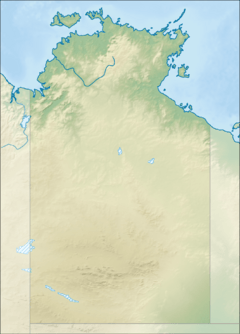Madjedbebe facts for kids
|
Madjedbebe
|
|
| Alternative name | Malakunanja II |
|---|---|
| Location | Arnhem Land |
| Region | Northern Territory |
| Coordinates | 12°30′S 132°53′E / 12.500°S 132.883°E |
| Type | Rock shelter site |
| History | |
| Periods | Pleistocene |
| Cultures | Aboriginal Australians |
| Site notes | |
| Excavation dates | 1973, 1989, 2012, 2015 |
| Archaeologists | Chris Clarkson Johan Kamminga, Rhys Jones, Mike Smith |
| Management | Mirrar traditional owners of lands |
| Public access | No |
Madjedbebe (also known as Malakunanja II) is a special rock shelter in Arnhem Land, Australia. It's thought to be the oldest place where humans lived in Australia. This important site is about 50 kilometers (31 miles) from the coast.
Madjedbebe is on the traditional lands of the Mirarr people. They are an Aboriginal Australian clan. Even though it's surrounded by the famous Kakadu National Park, Madjedbebe itself is in a mining area.
Contents
Discovering Ancient Life
Madjedbebe is the oldest known place in Australia where people have lived. Scientists believe humans first arrived here around 65,000 years ago. This makes it a very important site for understanding human history.
Amazing Finds at Madjedbebe
Archaeologists have dug up over 100,000 items at Madjedbebe. These items are called artifacts. Many of them were found deep underground, more than 2.5 meters (8 feet) below the surface.
Some of the cool things found include:
- Stone tools, like sharp flakes and ground axe heads.
- Grinding stones, used for preparing food.
- Animal bones and shells from meals.
- Pieces of ochre, a natural pigment used for art or decoration.
- Charcoal from ancient fires.
- Seeds and nuts, showing what plants people ate.
Scientists also found evidence that people ate plant foods. These included seeds, tubers (like potatoes), and pandanus nuts. They also used wood from local eucalyptus trees for fuel.
How We Know It's So Old
Scientists have studied Madjedbebe for many years. They use special methods to figure out how old the site and its artifacts are.
Early Discoveries
Researchers first wrote about Madjedbebe in the 1970s. Of course, the Mirarr people had always known about the site. In 1973, an archaeologist named Johan Kamminga dug a small test pit. He found signs that people had lived there a very long time ago, during the Pleistocene Ice Age.
The top part of the site had many shells, animal bones, and stone tools. Deeper down, it was mostly sand with more stone tools.
Dating the Site
In 1988, archaeologists Rhys Jones and Christopher Chippindale visited the site. They worked with a scientist named Richard Roberts. They used a new method called thermoluminescence dating. This method helps tell how long ago dirt and rocks were last exposed to sunlight.
In 1989, Jones and Roberts dug another test pit. Their tests suggested the site was about 50,000 years old. Some scientists questioned these dates at first. However, Roberts and his team were confident in their findings.
New Research and Debates
In 2012 and 2015, a team led by Christopher Clarkson dug at the site again. They worked with the Gundjeihmi Aboriginal Corporation. Their new research suggested the site was even older, possibly 65,000 years old!
This new date caused more discussion among scientists. Some still questioned how accurate it was. One study in 2020 even suggested that tiny creatures like termites might have moved things around, making the dates seem older. However, Clarkson's team stands by their findings.
Ancient Art on the Walls
Madjedbebe is famous for being an old archaeological site. But it also has many amazing rock art paintings on its walls.
Recording the Art
In 2012, a team from the Australian National University carefully recorded the rock art. They worked with the Mirarr people. They found over 1,000 different pictures and designs. Many images are faded or painted over, so there were likely many more in the past.
Types of Rock Art
The art at Madjedbebe includes different styles:
- Paintings: Made by using wet paint.
- Stencils: Created by spraying paint around an object held against the wall, leaving its shape blank.
- Drawings: Made by rubbing dry ochre or charcoal on the wall.
- Beeswax figures: Small shapes made from rolled-up beeswax stuck to the wall.
Artists used different colored pigments. Most were ochres (red, yellow, orange). They also used white clay (called kaolinite) and black charcoal.
What the Art Shows
The rock art is very important to the Mirarr people. The same picture can have different meanings for different people.
The art shows many things, including:
- Human-like figures.
- Geometric shapes.
- Hand stencils.
- Fish, like catfish and barramundi.
- Objects made from plant fibers.
- Items from when Europeans first arrived, like firearms, ships, and people wearing hats.
Dating the Art
It's hard to get exact dates for rock art. Scientists use relative dating methods instead. This means they compare the art layers to guess which ones are older or newer.
Most of the art seen today was probably made in the last 1,500 years. Some might be thousands of years old. It's likely that people painted here for much longer, but older paintings have faded away.
Interestingly, archaeologists found pieces of ochre with ground marks on them in the very oldest layers of the site. This hints that people might have been making art or decorating themselves even 65,000 years ago!



